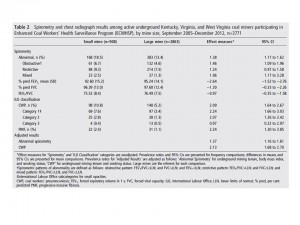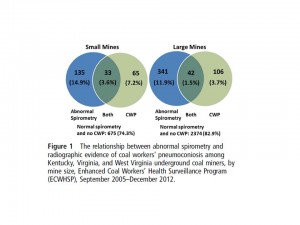NIOSH Study Finds Coal Miners at Small Mines More Likely to Have Black Lung

Some of the descriptions of coal mine dust in Chinese coal mines mirror those described in the Louisville Courier-Journal’s five-part black lung series, “Dust, Deception and Death”
In 1998, the Louisville Courier-Journal ran “Dust, Deception and Death,” a five-part investigation into the shocking prevalence of black lung in the mining industry. One story came from Adena Fuels’ Yellow Creek Mine in Knott County, KY, where the dust was so thick that the miners couldn’t see the controls on their mining machines.
“I ate my dust when I was cutting as well as [fellow miners’] Danny Shepherd’s dust when he was cutting,” said Larry Hatton. “You’re supposed to only operate one of the machines at a time, but I was told to operate all the time and only shut it down when an inspector was there.”
The dust was so dense, Hatton said, that he could barely breathe and began having heart trouble. Shepherd said he couldn’t even see the shuttle cars as they rolled up to the mining machine to get their coal.
Adena was a small non-union company that employed less than 50 people. The investigation pointed out that the dust conditions in its mine were not unique. By examining federal dust-test records, the journalists found that small, non-union mines had much higher rates of deaths, injuries and black lung.
Evidence of higher black lung rates in small mines has been largely anecdotal. Indeed, the Courier-Journal investigation only pointed out that these mines had higher dust levels, and could not put a number to the amount of miners that suffered from black lung as a result of employment in a small, non-union mine when compared to miners in large mines.
On July 22, 2014, Occupational and Environmental Medicine published a study (available here) by researchers from the National Institute for Occupational Safety and Health which characterizes, for the first time, the prevalence of abnormal lung function among coal miners with respect to mine size. The study focused on Kentucky, Virginia and West Virginia, and found that underground miners working in small mines (defined as mines with 50 or fewer underground employees) were more than twice as likely to have signs of black lung on x-ray and 37% more likely to have abnormal breathing results than those working in large mines.
As the table below demonstrates, 18.5% of miners working in small mines had abnormal spirometry results as compared to 13.4% of miners in large mines. The prevalence of x-ray evidence of coal workers’ pneumoconiosis (CWP) is 2.1 times higher in small mines than large mines (10.8% vs. 5.2%). Particularly concerning, rates of progressive massive fibrosis (PMF)—the most severe form of black lung—are also more than twice as high among miners in small mines (2.4% vs. 1.1%). This finding regarding PMF is troubling because this severe form of the disease was nearly eliminated from Central Appalachia during the 1990s.

[Click to enlarge]
CWP = Coal workers’ pneumoconiosis
PMF = Progressive massive fibrosis
Source – NIOSH
The Courier-Journal investigation certainly backs up this assessment. According to the authors, “Small, non-union mines generally pay less, cheat more on dust tests and don’t have union stewards demanding compliance with costly safety regulations.”
As the NIOSH authors stated:
“These results remind us that this remains an important public health problem more than four decades after enforceable dust limits were implemented, and suggest that for miners in certain portions of the industry, the burden of debilitating respiratory disease is currently higher than national and regional levels from 10, 20 or even 30 years ago. If implemented effectively, the protections outlined in MSHA’s rule to lower miners’ exposure to respirable dust represent historic and welcome progress in the effort to safeguard the health of US coal miners.”

4 Responses to “NIOSH Study Finds Coal Miners at Small Mines More Likely to Have Black Lung”
[…] appalling data comes amid findings that miners at small mines are more at risk of getting black lung than miners at large mines, and calls to reform the complex bureaucratic system that makes it hard […]
[…] association between disease prevalence and small mine size has been […]
[…] this, one is reminded of a passage from the Louisville Courier-Journal‘s five-part series on black … in America from 1998, “Dust, Deception and […]
[…] into the resurgence of black lung (for examples of Dr. Blackley’s research, see here, here, here, and […]
Comments are closed.